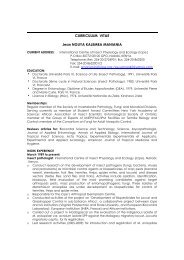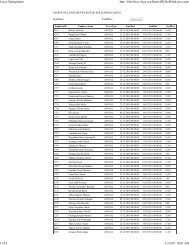Integrated control of thrips in vegetables in eastern Africa - icipe
Integrated control of thrips in vegetables in eastern Africa - icipe
Integrated control of thrips in vegetables in eastern Africa - icipe
You also want an ePaper? Increase the reach of your titles
YUMPU automatically turns print PDFs into web optimized ePapers that Google loves.
<strong>Integrated</strong> <strong>control</strong> <strong>of</strong> <strong>thrips</strong> <strong>in</strong> <strong>vegetables</strong> <strong>in</strong> <strong>eastern</strong> <strong>Africa</strong><br />
Annual Technical Report<br />
P. O. Box 30772-00100 Nairobi, Kenya<br />
Phone: +254 (20) 8632000; Fax: +254 (20) 8632001/2<br />
Email: <strong>icipe</strong>@<strong>icipe</strong>.org Website: www.<strong>icipe</strong>.org<br />
Feb 2009<br />
Project Leader: Dr. Subramanian Sevgan (ssubramania@<strong>icipe</strong>.org)<br />
Plant Health Division<br />
Report<strong>in</strong>g Period: January 2008 – December 2008.
1. Name <strong>of</strong> IARC<br />
The International Centre <strong>of</strong> Insect Physiology and Ecology (<strong>icipe</strong>)<br />
2. Project Title<br />
<strong>Integrated</strong> Control <strong>of</strong> Thrips <strong>in</strong> Vegetables <strong>in</strong> Eastern <strong>Africa</strong><br />
3. GTZ Project Number and Contract Number<br />
Project number: 07.7860.5-001.00<br />
Contract number: 81099947<br />
4. Report<strong>in</strong>g Period<br />
January 2008 - January 2009<br />
5. Project Coord<strong>in</strong>ator and Project Scientists<br />
International Centre <strong>of</strong> Insect Physiology and Ecology (<strong>icipe</strong>)<br />
Subramanian Sevgan, Entomologist, Pr<strong>in</strong>cipal <strong>in</strong>vestigator<br />
Postal address:<br />
ICIPE, P.O. Box 30772-00100<br />
Nairobi, Kenya<br />
Tel: +254 20 8632000<br />
Fax: +254 20 8632001/2<br />
Email: ssubramania@<strong>icipe</strong>.org<br />
Nguya K. Maniania, Arthropod Pathology Unit, Email: nmaniania@<strong>icipe</strong>.org<br />
Nyambo, Brigitte, Technology Transfer Unit,,bnyambo@<strong>icipe</strong>.org<br />
6. Collaborat<strong>in</strong>g Institutions and Staff <strong>in</strong>clud<strong>in</strong>g NARS and German Partners<br />
Kenya<br />
Dr. M. Waiganjo, Kenya Agriculture Research Institute (KARI), Thika, Email:<br />
monicahwaiganjo@yahoo.com<br />
Uganda<br />
Dr. Peter Sseruwagi, National Crops Resources Research Institute (NaCRRI), Namulonge,<br />
Kampala Email: psseruwagi@yahoo.co.uk<br />
Germany:<br />
Pr<strong>of</strong>. Dr. H. M. Poehl<strong>in</strong>g, Institute <strong>of</strong> Plant Diseases and Plant Protection, Gottfried Wilhelm<br />
Leibniz Universitat, Hannover Email: poehl<strong>in</strong>g@ipp.uni-hannover.de<br />
Pr<strong>of</strong>. Dr. G. W. Moritz, Department <strong>of</strong> Developmental Biology, Mart<strong>in</strong>-Luther-University <strong>of</strong> Halle-<br />
Wittenberg, Halle (Saale) Email: moritz@zoologie.uni-halle.de<br />
7. Project Description<br />
The proposed project seeks to develop environmentally friendly <strong>control</strong> options for Western Flower<br />
Thrips (WFT), Frankl<strong>in</strong>iella occidentalis (Pergande) and other <strong>thrips</strong> <strong>in</strong> vegetable production systems <strong>in</strong><br />
East <strong>Africa</strong>. Thrips <strong>in</strong>festations cause huge losses <strong>in</strong> horticultural production <strong>in</strong> the region and current<br />
<strong>control</strong> practices are exclusively based on the use <strong>of</strong> synthetic <strong>in</strong>secticides lead<strong>in</strong>g to resistance and<br />
environmental contam<strong>in</strong>ation. The Project seeks to build on exist<strong>in</strong>g knowledge with<strong>in</strong> <strong>icipe</strong> and its<br />
partners and to address jo<strong>in</strong>tly the identified research gaps towards an environmentally friendly<br />
management approach for <strong>thrips</strong> <strong>control</strong>. The project goal and long-term purpose are as follows:<br />
Project goal:<br />
Enhance food security and reduce poverty through susta<strong>in</strong>able crop production.
Project purpose:<br />
Pest status <strong>of</strong> <strong>thrips</strong> greatly reduced by environmentally friendly <strong>control</strong> methods.<br />
Output 1: Identity, importance and distribution <strong>of</strong> major plant <strong>in</strong>fest<strong>in</strong>g <strong>thrips</strong> studied <strong>in</strong> Kenya and<br />
Uganda.<br />
Output 2: Field ecology and dispersion <strong>of</strong> Frankl<strong>in</strong>iella occidentalis studied on French beans <strong>in</strong><br />
Kenya.<br />
Output 3: Metarhizium-based <strong>control</strong> product developed.<br />
Output 4: Additional environmentally friendly <strong>control</strong> options tested <strong>in</strong> the greenhouse and field and<br />
IPM strategy developed.<br />
Output 5: Technology Transfer & Tra<strong>in</strong><strong>in</strong>g program <strong>in</strong>itiated with national partners.<br />
8. Progress <strong>of</strong> activities<br />
8.1 Brief summary <strong>of</strong> the various outputs<br />
Output 1: Identity, importance and distribution <strong>of</strong> major plant <strong>in</strong>fest<strong>in</strong>g <strong>thrips</strong> studied <strong>in</strong> Kenya and<br />
Uganda.<br />
• Over 60 locations cover<strong>in</strong>g 12 districts distributed with<strong>in</strong> five prov<strong>in</strong>ces <strong>in</strong> Kenya were surveyed<br />
• Reference collections <strong>of</strong> more than 2100 slide mounted <strong>thrips</strong> specimens established. Database on<br />
the alternate host plants for various <strong>thrips</strong> have been established<br />
• Western Flower <strong>thrips</strong> (WFT), Frankl<strong>in</strong>iella occidentalis was abundant <strong>in</strong> highlands,<br />
Ceratothripoides sp, tomato <strong>thrips</strong> were found <strong>in</strong> the low semi arid regions<br />
• WFT was a key pest on French beans, Bean Flower <strong>thrips</strong>, Megaluro<strong>thrips</strong> sjostedti was found on<br />
Lablab, cowpea and common bean, Ceratothripoides sp. was abundant on solanaceaous<br />
<strong>vegetables</strong> and onion <strong>thrips</strong>, Thrips tabaci was widely present <strong>in</strong> Liliaceous and Cruciferous<br />
<strong>vegetables</strong><br />
• Predatory <strong>thrips</strong> were found to be widely distributed however with very little abundance<br />
• Chilli <strong>thrips</strong>, Sciro<strong>thrips</strong> dorsalis yet another <strong>in</strong>vasive pest from Asia was found to be distributed <strong>in</strong><br />
chillies, capsicum and bitter gourds.<br />
Output 2: Field ecology and dispersion <strong>of</strong> Frankl<strong>in</strong>iella occidentalis studied on French beans <strong>in</strong> Kenya.<br />
• A Ph.D student from Kenya was recruited <strong>in</strong> January 2009. The second draft <strong>of</strong> the proposal has<br />
been submitted for review by the supervisors <strong>in</strong> Hannover and <strong>icipe</strong><br />
• Field experiments to evaluate the field ecology and dispersion <strong>of</strong> WFT on French bean <strong>in</strong>itiated <strong>in</strong><br />
December 2009 at KARI, Embu<br />
Output 3: Metarhizium-based <strong>control</strong> product developed.<br />
• A PhD student from Sénégal was recruited and jo<strong>in</strong>ed the ARPPIS programme <strong>in</strong> October 2008.<br />
The first draft <strong>of</strong> the proposal has been submitted for review<br />
• Mass cultur<strong>in</strong>g <strong>of</strong> selected Beauveria bassiana and Metarhizium isolates and bioassays <strong>in</strong>itiated<br />
Output 4: Additional environmentally friendly <strong>control</strong> options tested <strong>in</strong> the greenhouse and field and<br />
IPM strategy developed.<br />
• Green house evaluation <strong>of</strong> botanicals aga<strong>in</strong>st WFT have been <strong>in</strong>itiated<br />
• Field evaluation <strong>of</strong> <strong>in</strong>fluence <strong>of</strong> <strong>in</strong>tercropp<strong>in</strong>g French bean with baby corn, sunflower and potato<br />
<strong>in</strong>itiated <strong>in</strong> December 2009<br />
Output 5: Technology Transfer & Tra<strong>in</strong><strong>in</strong>g program <strong>in</strong>itiated with national partners.<br />
• A taxonomic tra<strong>in</strong><strong>in</strong>g on <strong>thrips</strong> collection and identification provided to members <strong>of</strong> the partner<br />
<strong>in</strong>stitutes, quarant<strong>in</strong>e organization, regional universities and East <strong>Africa</strong>n Growers Association
• Thrips Identification s<strong>of</strong>tware was provided to the partner <strong>in</strong>stitutes and quarant<strong>in</strong>e organizations.<br />
NaCRRI, Uganda contributes to the output 1; While KARI contributes to output 2 and 4.<br />
9. Achievements and Constra<strong>in</strong>ts<br />
9.1. Output 1: Identity, importance and distribution <strong>of</strong> major plant <strong>in</strong>fest<strong>in</strong>g <strong>thrips</strong> studied <strong>in</strong> Kenya and<br />
Uganda.<br />
Information on the <strong>thrips</strong> fauna and their importance <strong>in</strong> East <strong>Africa</strong> is very scarce. This <strong>in</strong>formation is<br />
very important to prioritize the key pest <strong>thrips</strong> and target vegetable crops for formulation <strong>of</strong> region<br />
specific and species specific management strategies. In this regard a nationwide survey on <strong>thrips</strong> fauna<br />
associated with key <strong>vegetables</strong> and their associated plants were <strong>in</strong>itiated <strong>in</strong> August, 2008 <strong>in</strong> Kenya.<br />
Over 60 locations cover<strong>in</strong>g 12 districts distributed with<strong>in</strong> five prov<strong>in</strong>ces (Nairobi, Central, Eastern, Rift<br />
Valley and Western Prov<strong>in</strong>ces) <strong>in</strong> Kenya and <strong>in</strong> Kampala, Uganda were surveyed. More than 2100<br />
<strong>thrips</strong> specimens have been collected, slide mounted, identified and a database established.<br />
The important <strong>thrips</strong> species <strong>in</strong> terms <strong>of</strong> abundance, encountered <strong>in</strong> the survey were onion <strong>thrips</strong>,<br />
Western flower <strong>thrips</strong>, tomato <strong>thrips</strong>, Ceratothripoides sp. and Bean flower <strong>thrips</strong>. Apart from the<br />
important species listed above more than 20 terebrantian and many tubelliferan <strong>thrips</strong> were observed.<br />
Onion <strong>thrips</strong> (Thrips tabaci, L<strong>in</strong>deman 1988) was abundant both <strong>in</strong> the highlands (Gilgil, Naivasha<br />
and Lari) and <strong>in</strong> upper midlands (Kajiado and Nairobi), and less abundant <strong>in</strong> lowlands <strong>of</strong> Yatta <strong>in</strong> Kenya<br />
and Namulonge <strong>in</strong> Uganda. T. tabaci was a key pest <strong>of</strong> onion and cruciferous <strong>vegetables</strong>. This species<br />
was collected from more than 44 host plant species belong<strong>in</strong>g to 15 families.<br />
Western Flower <strong>thrips</strong> (Frankl<strong>in</strong>iella occidentalis, Pergande, 1895) was distributed <strong>in</strong> most <strong>of</strong> the<br />
locations surveyed however they were quiet abundant <strong>in</strong> the highlands <strong>of</strong> Gilgil, Naivasha and Lari<br />
divisions as compared to the lowlands (Yatta and Namulonge). The western flower <strong>thrips</strong> was a key<br />
pest <strong>in</strong> French beans and tomato. This species was collected from more than 47 host plant species<br />
belong<strong>in</strong>g to 18 families.<br />
Tomato <strong>thrips</strong> (Frankl<strong>in</strong>iella schultezi, Trybom, 1910) is native to this region and it was distributed <strong>in</strong><br />
most <strong>of</strong> the locations surveyed it was more abundant <strong>in</strong> the lowlands <strong>of</strong> Yatta and Namulonge as<br />
compared to the highlands. This species is widely found on French bean, potato and cucurbits. It was<br />
observed <strong>in</strong> more that 52 plant species belong<strong>in</strong>g to 21 families.<br />
Ceratothripoides sp. was widely distributed <strong>in</strong> Embu, Kenya and <strong>in</strong> lowlands such as Athi River <strong>in</strong><br />
Kenya and Namulonge <strong>in</strong> Uganda. However it was significantly absent <strong>in</strong> the highlands <strong>of</strong> Naivasha,<br />
Gilgil and Lari. This species was predom<strong>in</strong>antly observed <strong>in</strong> solanaceous crops like tomato, potato and<br />
eggplant, <strong>Africa</strong>n nightshade etc. It was observed <strong>in</strong> 23 plant species belong<strong>in</strong>g to 15 families.<br />
Incidentally this native species has been <strong>in</strong>tercepted by UK plant health Inspection service from Karela<br />
exported from Kenya and notified <strong>in</strong> the EPPO <strong>in</strong> 2005.<br />
The Bean Flower <strong>thrips</strong> (Megaluro<strong>thrips</strong> sjostedti, Trybom, 1908) was widely distributed <strong>in</strong><br />
lowlands as compared to the highlands. The BFT was observed <strong>in</strong> more than 32 plant species<br />
belong<strong>in</strong>g to 14 plant families. This species as reported earlier was predom<strong>in</strong>antly observed <strong>in</strong><br />
fabaceous crops such as French bean, common bean, broad bean, lablab etc. Among the other<br />
species observed <strong>in</strong> the survey, the chilli <strong>thrips</strong>, Scirto<strong>thrips</strong> dorsalis was found to be distributed <strong>in</strong> the<br />
lowlands on chillies, capsicum and bitter gourd. Specimens have been sent to Dr. Moritz for<br />
confirmation <strong>of</strong> identity. Incidentally this species aga<strong>in</strong> is an <strong>in</strong>vasive species with South Asia as the<br />
centre <strong>of</strong> orig<strong>in</strong>. This pest aga<strong>in</strong> was <strong>in</strong>tercepted <strong>in</strong> 2003 by the UK plant quarant<strong>in</strong>e from bitter gourd<br />
exported to UK from Kenya. However no <strong>in</strong>formation on the distribution <strong>of</strong> this pest exists <strong>in</strong> Kenya.<br />
More detailed survey on host plants and distribution <strong>of</strong> this species is needed.<br />
Predatory <strong>thrips</strong> (Aeolo<strong>thrips</strong> sp.), parasitoids and pirate bugs were the commonly encountered natural<br />
enemies however less abundant.<br />
Surveys <strong>in</strong> the next 6-10 months will cover the Coast, Nyanza, Western, Rift valley and Eastern<br />
prov<strong>in</strong>ces <strong>in</strong> Kenya and more locations <strong>in</strong> Uganda.
9.2. Output 2: Field ecology and dispersion <strong>of</strong> Frankl<strong>in</strong>iella occidentalis studied on French<br />
beans <strong>in</strong> Kenya<br />
Western flower <strong>thrips</strong> probably <strong>in</strong>vades fields from <strong>in</strong>fested plants <strong>in</strong> neighbor<strong>in</strong>g fields and field<br />
marg<strong>in</strong>s. However, detailed knowledge on the spatial pattern <strong>of</strong> the <strong>in</strong>vasion as well as on the<br />
secondary spread <strong>in</strong> the field and <strong>in</strong>fluence <strong>of</strong> abiotic and biotic factors is not available. Experiments<br />
with<strong>in</strong> this output will address some the above research gaps and it will form a part <strong>of</strong> a Ph. D student<br />
thesis jo<strong>in</strong>tly supervised by partners <strong>in</strong> University <strong>of</strong> Hannover.<br />
A Ph. D student identified from Hannover participated <strong>in</strong> the plann<strong>in</strong>g meet<strong>in</strong>g organized July 2008.<br />
However the student subsequently decl<strong>in</strong>ed to take up the <strong>of</strong>fer. In this regard, prospective students<br />
from Kenya and Uganda were screened and a student from Kenya has been selected <strong>in</strong> consensus<br />
with partners <strong>in</strong> Hannover. The student jo<strong>in</strong>ed the program <strong>in</strong> January 2009. The second draft <strong>of</strong> the<br />
research proposal has been submitted for review by the supervisors <strong>in</strong> Hannover and <strong>icipe</strong>.<br />
Large –scale and small scale farm fields have been identified <strong>in</strong> Thika and Embu to evaluate the<br />
population dynamics <strong>of</strong> <strong>thrips</strong> <strong>in</strong> French bean over seasons. Surveys on the <strong>thrips</strong> diversity <strong>in</strong> Kenya<br />
have revealed regional differences <strong>in</strong> distribution <strong>of</strong> key pest <strong>thrips</strong>. Evaluation <strong>of</strong> the population<br />
dynamics over different seasons will provide us <strong>in</strong>formation on the seasonal variations. It will also<br />
enable us to understand the <strong>in</strong>fluence <strong>of</strong> large-scale, high <strong>in</strong>tensive and less diverse farm<strong>in</strong>g system as<br />
compared to small-scale, low <strong>in</strong>tensive and diverse farm<strong>in</strong>g system.<br />
Field experiments to evaluate the population ecology and dispersion <strong>of</strong> WFT have been <strong>in</strong>itiated <strong>in</strong> the<br />
KARI, Embu <strong>in</strong> December, 2009. The <strong>in</strong>fluence <strong>of</strong> <strong>in</strong>tercrops such as baby corn, sunflower and potato<br />
on dynamics <strong>of</strong> <strong>thrips</strong> population on French bean will be simultaneously evaluated.<br />
9.3. Output 3: Metarhizium-based <strong>control</strong> product developed.<br />
Beauveria bassiana and Metarhizium anisopliae are potential microbial <strong>control</strong> agents that can be<br />
utilized for management <strong>of</strong> <strong>thrips</strong>. Previous studies at <strong>icipe</strong> have led to the identification <strong>of</strong> a virulent<br />
isolate <strong>of</strong> Metarhizium anisopliae (<strong>icipe</strong>69) aga<strong>in</strong>st the bean flower <strong>thrips</strong>. Its efficacy has been proven<br />
<strong>in</strong> the field aga<strong>in</strong>st flower <strong>thrips</strong>, the onion <strong>thrips</strong>, the western flower <strong>thrips</strong> <strong>in</strong> cut flower and runner<br />
bean, and at less extent aga<strong>in</strong>st the western flower <strong>thrips</strong> on French bean.<br />
A Ph.D student jo<strong>in</strong>ed the ARPPIS programme <strong>in</strong> October 2008 to undertake activities perta<strong>in</strong><strong>in</strong>g to this<br />
output. The student has submitted the first draft <strong>of</strong> the proposal for review by the <strong>icipe</strong>’s supervisors.<br />
The student has already started cultur<strong>in</strong>g fungal isolates from the <strong>icipe</strong>’s Arthropod Germplasm Centre<br />
and <strong>in</strong>itiated bioassays aga<strong>in</strong>st the WFT. Eight isolates <strong>of</strong> M. anisopliae and 7 isolates <strong>of</strong> B. bassiana<br />
are ready so far for screen<strong>in</strong>g. Virulent B. bassiana isolates will be further screened for their endophytic<br />
properties <strong>in</strong> selected host plants.<br />
9.4. Output 4: Additional environmentally friendly <strong>control</strong> options tested <strong>in</strong> the greenhouse and<br />
field and IPM strategy developed.<br />
Green house experiments have been <strong>in</strong>itiated <strong>in</strong> December 2009 for evaluation <strong>of</strong> botanical pesticides<br />
such as neem, pyrethrum and garlic extracts for the management <strong>of</strong> WFT. Both soil and foliar<br />
application <strong>of</strong> the above botanicals are evaluated. Further laboratory bioassays will be conducted to<br />
screen for effective botanical pesticides.<br />
Effectiveness <strong>of</strong> plastic mulches and live mulches for management <strong>of</strong> <strong>thrips</strong> will be evaluated <strong>in</strong> small<br />
scale field trials to be established by Feb 2009. Based on the outcome <strong>of</strong> the above experiments, field<br />
trials with French bean to evaluate the best treatments will be <strong>in</strong>itated by June 2009.<br />
Role <strong>of</strong> <strong>in</strong>tercropp<strong>in</strong>g French bean with babycorn, sunflower and potato for the management <strong>of</strong> western<br />
flower <strong>thrips</strong> will be evaluated, simultaneously with the field ecology experiments.
9.5. Output 5: Technology Transfer & Tra<strong>in</strong><strong>in</strong>g program <strong>in</strong>itiated with national partners.<br />
Tra<strong>in</strong><strong>in</strong>g on collection, process<strong>in</strong>g and identification <strong>of</strong> <strong>thrips</strong> was provided by Pr<strong>of</strong>. Gerald Moritz<br />
immediately after the Project plann<strong>in</strong>g meet<strong>in</strong>g. Members from partner <strong>in</strong>stitutes, KARI, UMU, KEPHIS,<br />
regional universities like JKUAT, Kenya, Makerere University, Uganda and grower organization like<br />
East <strong>Africa</strong>n Growers, technicians and students likely to be <strong>in</strong>volved <strong>in</strong> the project activities were<br />
tra<strong>in</strong>ed. Subsequently <strong>thrips</strong> identification s<strong>of</strong>tware was also provided to organizations such as KARI,<br />
KEPHIS, Kenya and NaCRRI, Uganda. Along with the identification s<strong>of</strong>twares a refresher course on<br />
identification <strong>of</strong> <strong>thrips</strong> was also organized <strong>in</strong> NaCRRI and KARI, Thika.<br />
10. Conclusions for the follow<strong>in</strong>g Report<strong>in</strong>g Period<br />
Key pest <strong>thrips</strong> on various <strong>vegetables</strong> and regional differences <strong>in</strong> the diversity <strong>of</strong> the <strong>thrips</strong> complex<br />
have been identified and further surveys are on-go<strong>in</strong>g. Complete <strong>in</strong>formation on the <strong>thrips</strong> diversity and<br />
abundance <strong>in</strong> Kenya will be available by June 2008 when the surveys will be completed. Agreements<br />
and work plans have been formalized with partners <strong>in</strong> Uganda and activities <strong>in</strong>itiated <strong>in</strong> January 2009.<br />
Representatives <strong>of</strong> partner <strong>in</strong>stitutes, regional universities, quarant<strong>in</strong>e organizations and grower<br />
organizations were tra<strong>in</strong>ed on taxonomic identification <strong>of</strong> <strong>thrips</strong>. Activities perta<strong>in</strong><strong>in</strong>g to field ecology<br />
studies, entomopathogens and cultural <strong>control</strong> <strong>of</strong> <strong>thrips</strong> have been <strong>in</strong>itiated with greenhouse and field<br />
experiments. Initial surveys revealed the prevalence <strong>of</strong> another <strong>in</strong>vasive pest <strong>thrips</strong>, chilli <strong>thrips</strong>,<br />
Scirto<strong>thrips</strong> dorsalis? <strong>in</strong> the agro-ecosystem especially on chillies and karela. More detailed studies on<br />
the identity, distribution, ecology and extent <strong>of</strong> damage <strong>of</strong> this pest will be undertaken. To understand<br />
the seasonal variations and impact <strong>of</strong> farm management practices on dynamics <strong>of</strong> pest <strong>thrips</strong>, identified<br />
small and large scale farm hold<strong>in</strong>gs <strong>in</strong> different regions will be surveyed over seasons for <strong>thrips</strong> and<br />
their natural enemies. Detailed <strong>in</strong>vestigation on the diversity and importance <strong>of</strong> tospoviruses vectored<br />
by different <strong>thrips</strong> will also be carried out. Outputs from the survey will be utilized to develop a userfriendly<br />
taxonomic tool for <strong>thrips</strong> complex <strong>in</strong> <strong>Africa</strong> and to identify prospective sites for exploration <strong>of</strong><br />
natural enemies for <strong>in</strong>vasive pest <strong>thrips</strong> <strong>in</strong> their native centers <strong>of</strong> orig<strong>in</strong>.<br />
The implementation <strong>of</strong> the project activities were delayed dur<strong>in</strong>g the first six months <strong>of</strong> 2008 due to the<br />
departure <strong>of</strong> the previous project coord<strong>in</strong>ator from <strong>icipe</strong>. However this delay <strong>in</strong> the implementation will<br />
be suitably addressed with the progression <strong>of</strong> project activities.<br />
11. Publications, Papers and Reports<br />
CD-ROM <strong>of</strong> presentations and discussions at the 1 st project plann<strong>in</strong>g meet<strong>in</strong>g, July 28 th – 29 th , 2008,<br />
<strong>icipe</strong>, Nairobi, Kenya<br />
CD-ROM <strong>of</strong> presentations and lectures delivered at the <strong>thrips</strong> taxonomy tra<strong>in</strong><strong>in</strong>g program organized by<br />
Dr. Gerald Moritz, Mart<strong>in</strong>-Luther University, Germany for stakeholders, July 30 th – 31 st , <strong>icipe</strong>, Nairobi,<br />
Kenya







